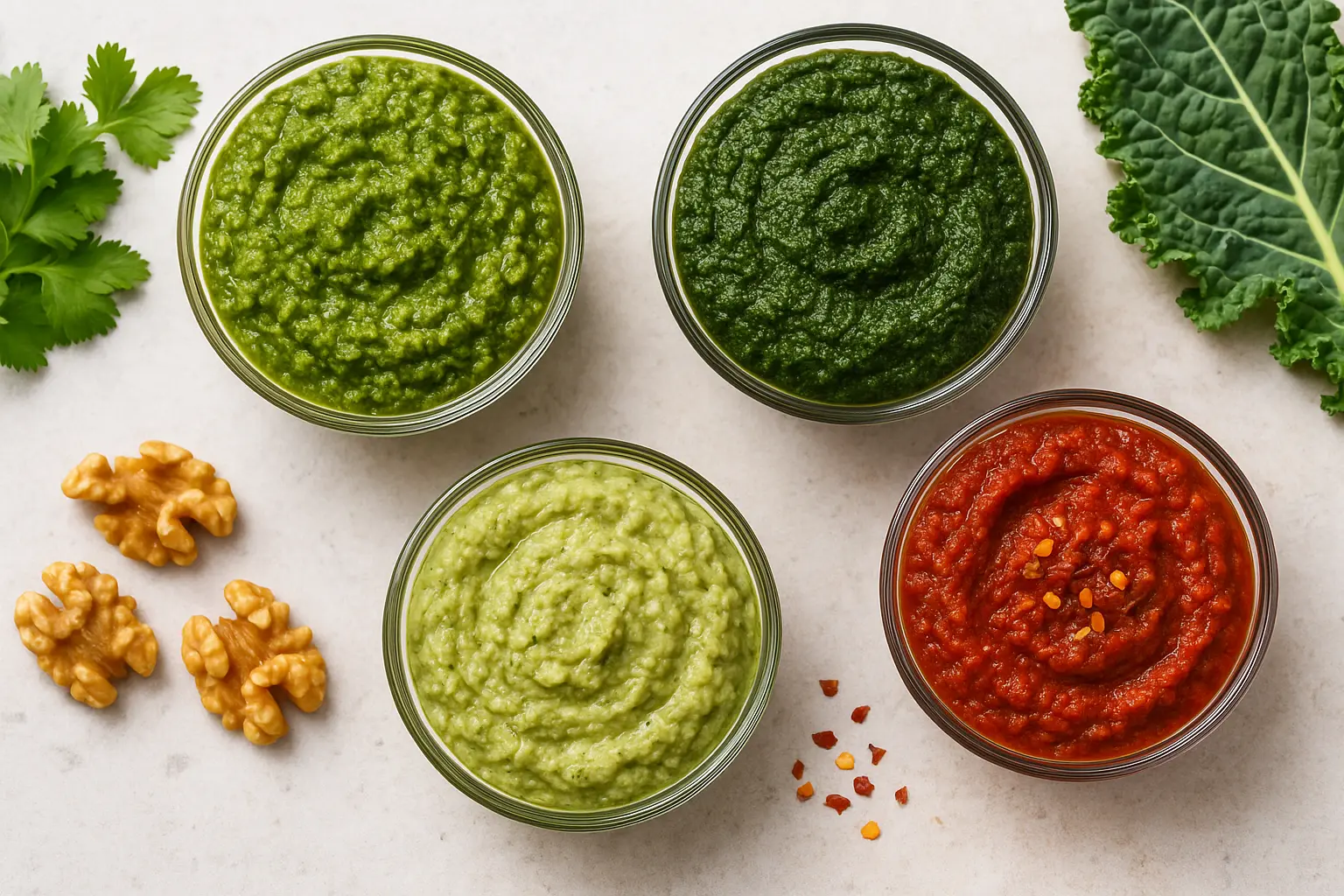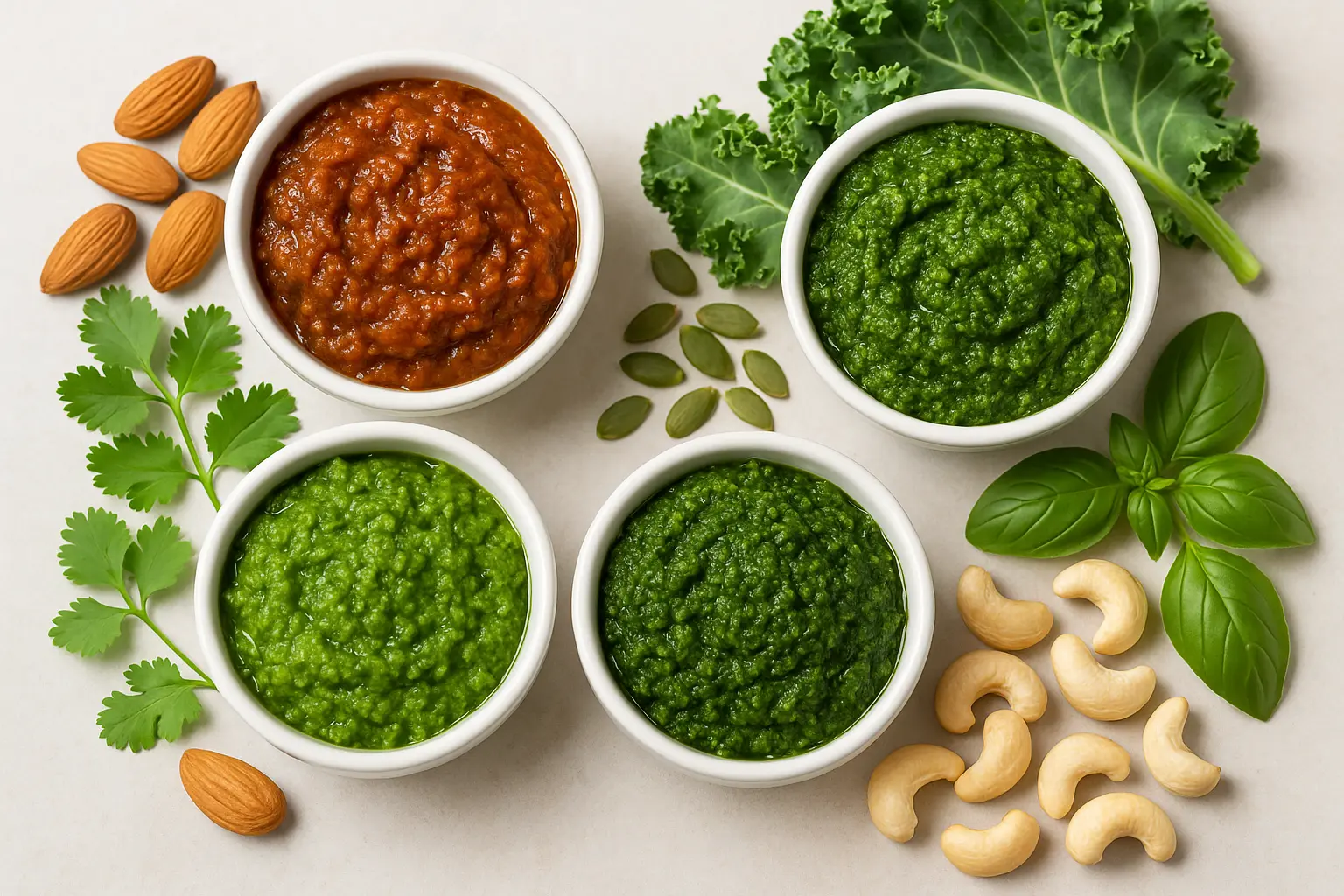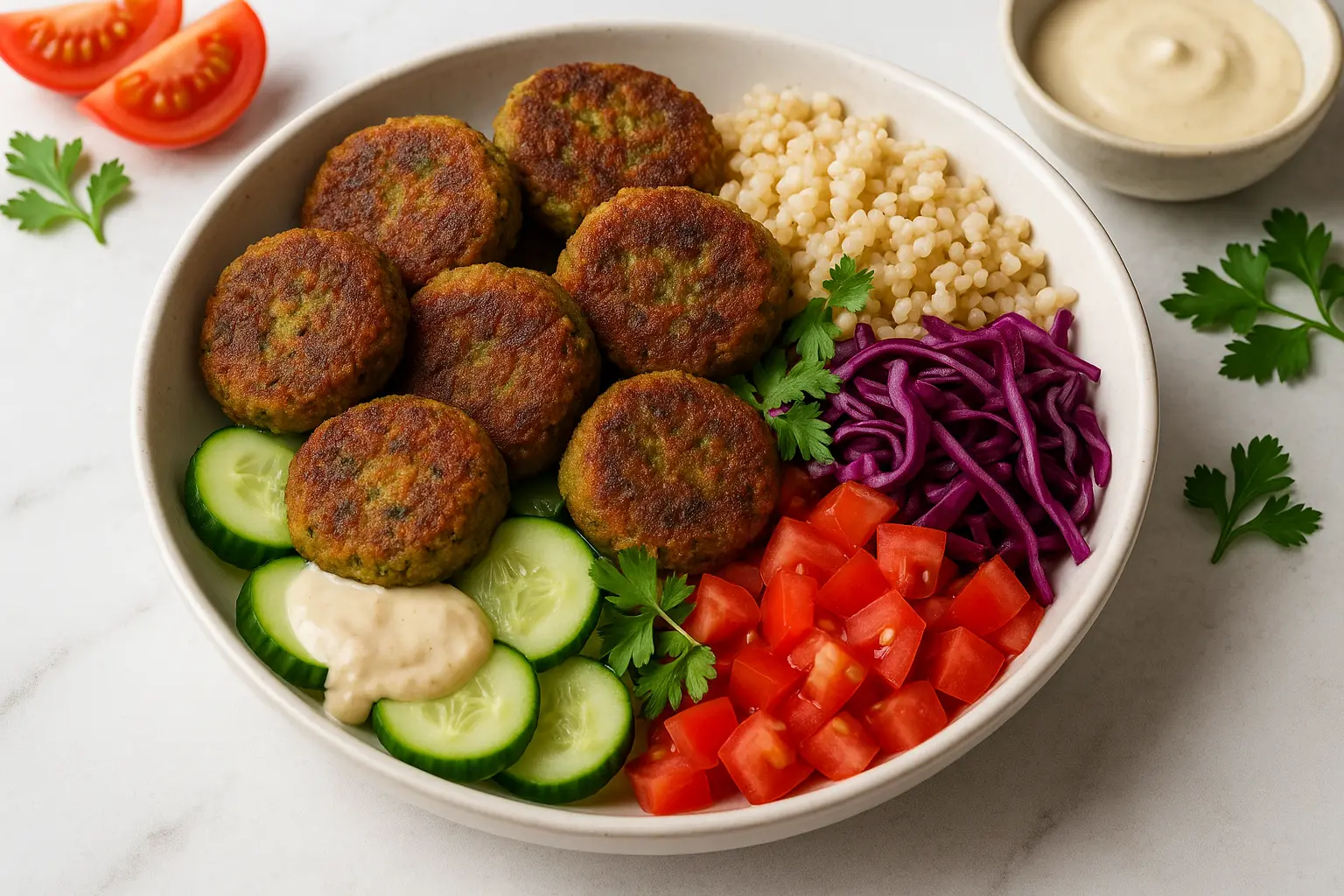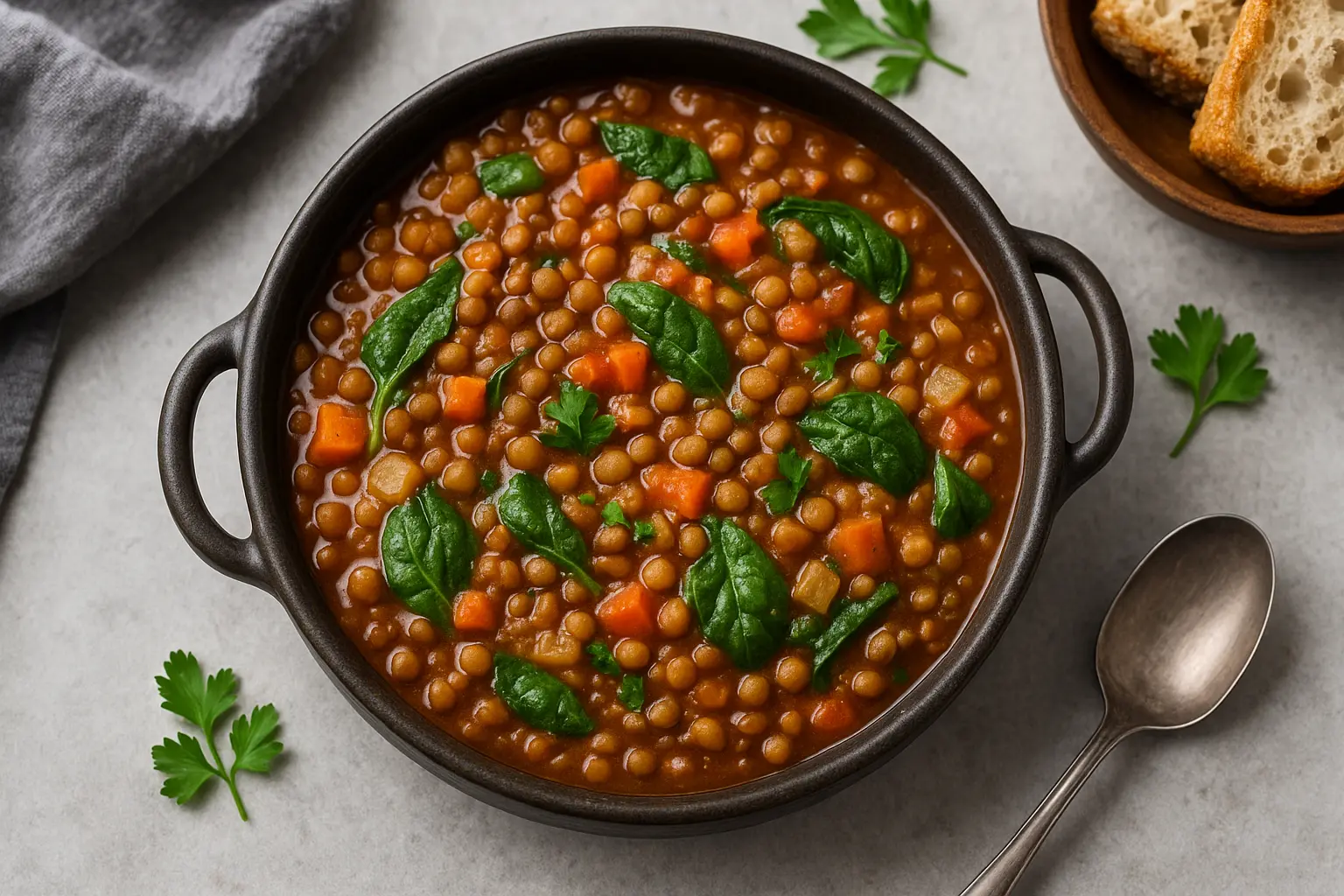When most of us think of pesto, one image comes to mind: a vibrant green paste of fresh basil, pine nuts, Parmesan, garlic, and olive oil. But the truth is, pesto is more than just basil. The word “pesto” comes from the Italian verb pestare, meaning “to pound or crush.” Historically, it was any sauce made by grinding ingredients together—usually in a mortar and pestle.
In today’s kitchens, pesto has evolved far beyond its Genoese roots. From leafy greens like kale and spinach to herbs such as coriander and parsley, and even unexpected ingredients like sun-dried tomatoes or roasted peppers, pesto has become one of the most adaptable condiments in the global food scene.
This article takes you through pesto recipes beyond basil—vegan, pantry-friendly, globally inspired, and incredibly versatile. Whether you’re tossing it through pasta, spreading it on sandwiches, or using it as a dip, these pestos will add bold flavor to everyday meals.

Why Go Beyond Basil?
Seasonal flexibility: Basil is a summer herb. In winter, kale, spinach, or parsley can step in beautifully.
Dietary inclusivity: Many modern pestos can be vegan, dairy-free, or nut-free while still packing in flavor.
Global influences: Different cultures use fresh herbs and seeds in sauces that resemble pesto—think Mexican cilantro salsa or Middle Eastern zhug.
Budget-friendly swaps: Pine nuts can be pricey; almonds, sunflower seeds, or pumpkin seeds are affordable alternatives.
Core Formula for Any Pesto
Before diving into variations, here’s the universal pesto blueprint:
Greens/Herbs – Basil, kale, spinach, rocket, parsley, coriander, or even carrot tops.
Nuts/Seeds – Pine nuts, almonds, walnuts, cashews, sunflower seeds, pumpkin seeds.
Aromatic Base – Garlic, shallots, or roasted onions.
Acidity & Umami – Lemon juice, lime juice, nutritional yeast, miso paste, or vinegar.
Oil – Olive oil is classic, but avocado oil or grapeseed oil also work.
Seasoning – Salt, pepper, chili flakes, or spices.
This adaptable template means you can create dozens of unique pestos by swapping just one or two ingredients.
Classic Alternatives: Leafy Green Pestos
1. Kale Pesto (Vegan Powerhouse)
Kale’s robust, slightly bitter flavor makes it a hearty base. Blend curly or Tuscan kale with walnuts, garlic, lemon juice, nutritional yeast, and olive oil. The result is a vibrant pesto that’s perfect for pasta bowls, grain salads, or spreading on sourdough toast.
Best For: Weeknight pasta, Buddha bowls, roasted vegetables.
2. Spinach & Almond Pesto
Spinach offers a mild, sweet flavor that pairs beautifully with almonds. A touch of lemon zest brightens it. Unlike basil pesto, spinach won’t oxidize as quickly, making this ideal for meal prep.
Best For: Freezer storage, kids’ lunchbox pasta, sandwich spread.
3. Rocket (Arugula) Pesto
Peppery rocket transforms into a punchy, slightly spicy pesto. Pair with walnuts or cashews, garlic, lemon juice, and olive oil. It works brilliantly with roasted potatoes or as a pizza drizzle.
Best For: Potato salad, pizza base, grilled veggie wraps.
4. Parsley Pesto
Parsley gives a fresh, grassy note with a hint of bitterness. Pair with sunflower seeds, garlic, olive oil, and nutritional yeast. Parsley pesto is particularly good with seafood substitutes (like vegan “tuna” pasta) or Mediterranean mezze.
Best For: Mezze platters, vegan seafood pasta, dips.
Global-Inspired Pesto Variations
5. Coriander (Cilantro) Pesto – Mexican & Asian Twist
Coriander leaves (and stems) blended with lime juice, cashews, garlic, and chili flakes create a zesty, globally inspired pesto. It resembles Mexican salsa verde or Indian chutneys.
Best For: Taco topping, rice bowls, Asian noodles.
6. Mint Pesto – Middle Eastern Style
Fresh mint leaves paired with almonds, lemon juice, olive oil, and a hint of cumin bring a refreshing take. Great as a dip for falafel or as a drizzle over grilled vegetables.
Best For: Falafel wraps, couscous, roasted eggplant.
7. Sun-Dried Tomato Pesto (Pesto Rosso)
A Sicilian classic, this uses sun-dried tomatoes, almonds, garlic, olive oil, and chili flakes. Rich, savory, and slightly sweet.
Best For: Bruschetta spread, pasta salads, grain bowls.
8. Roasted Red Pepper Pesto
Smoky roasted peppers blended with cashews, olive oil, garlic, and paprika create a vibrant red pesto.
Best For: Sandwiches, pasta sauce, dip for breadsticks.
9. Thai-Inspired Pesto
Blend Thai basil, coriander, peanuts, garlic, lime juice, and chili for a bold, Southeast Asian twist.
Best For: Stir-fries, rice noodles, satay skewers.
10. Indian-Inspired Coriander-Mint Pesto
Combining coriander, mint, green chilies, roasted peanuts, and lime makes a chutney-style pesto perfect for Indian-inspired fusion dishes.
Best For: Dosa spread, sandwich chutney, samosa dip.
Nut-Free and Allergy-Friendly Pestos
11. Sunflower Seed Pesto
Budget-friendly and nut-free, sunflower seeds bring creaminess and mild nuttiness. Pair with spinach, parsley, garlic, and lemon juice.
12. Pumpkin Seed (Pepita) Pesto
Pepitas are a Mexican staple. Toasted lightly, they make a vibrant green pesto with coriander and lime.
13. Hemp Seed Pesto
Packed with omega-3s, hemp seeds give a creamy, nutty base for kale or spinach pestos.
Creative Twists
14. Carrot Top Pesto
Don’t toss carrot greens! Blend them with walnuts, lemon juice, garlic, and olive oil. It’s sustainable, reduces food waste, and tastes earthy.
15. Broccoli Stem Pesto
Steam broccoli stems and blend with cashews, garlic, and olive oil for a mild, creamy pesto.
16. Avocado Pesto
Avocado adds richness, making a creamy spread without too much oil. Combine with coriander, lime juice, and pumpkin seeds.
How to Use Pesto Beyond Pasta
Sandwiches & Wraps: Spread instead of mayo.
Pizza Base: Use pesto as a sauce instead of tomato.
Grain Bowls: Toss through quinoa, farro, or couscous.
Marinade: Coat veggies before roasting or grilling.
Soup Swirl: Add a spoonful to minestrone, lentil soup, or tomato soup.
Dip: Serve with crudités, pita chips, or crackers.
Storage & Meal Prep Tips
Fridge: Store in a sealed jar topped with olive oil for up to 1 week.
Freezer: Portion into ice cube trays for up to 3 months.
Oxidation Tip: A splash of lemon juice or covering with extra oil keeps the color vibrant.
Frequently Asked Questions
Q: Can pesto be made without oil?
Yes. Use avocado, silken tofu, or even a splash of water for a lighter version.
Q: Is pesto always vegan?
Traditional pesto includes Parmesan, but vegan versions swap it with nutritional yeast, miso, or cashew cheese.
Q: Can I mix herbs?
Absolutely. Try half basil, half parsley or kale for balance.
Conclusion
Pesto is no longer limited to basil and pine nuts—it’s a canvas for creativity. By experimenting with greens, nuts, seeds, and global flavors, you can create pestos tailored to seasons, diets, and cuisines. Pantry-friendly, vegan, and versatile, these pestos prove that beyond basil lies a whole world of possibilities.
Whether you’re making kale pesto pasta on a weeknight, coriander pesto tacos for a party, or sun-dried tomato pesto for a mezze platter, one thing is certain: homemade pesto will always elevate your meals.
Leave a comment
Your email address will not be published. Required fields are marked *




















